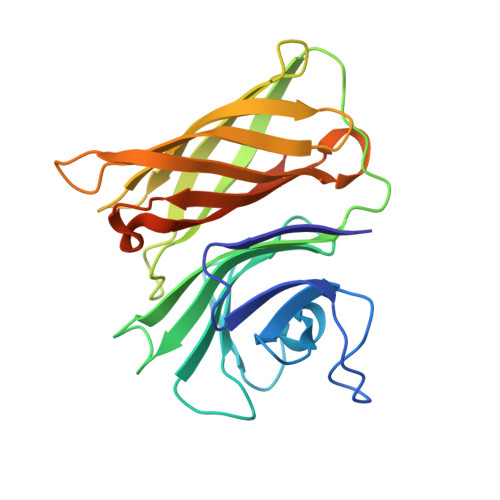Prevalence of Slam-dependent hemophilins in Gram-negative bacteria.
Shin, H.E., Pan, C., Curran, D.M., Bateman, T.J., Chong, D.H.Y., Ng, D., Shah, M., Moraes, T.F.(2024) J Bacteriol 206: e0002724-e0002724
- PubMed: 38814789
- DOI: https://doi.org/10.1128/jb.00027-24
- Primary Citation of Related Structures:
8GLO, 8GM3, 8GMM - PubMed Abstract:
Iron acquisition systems are crucial for pathogen growth and survival in iron-limiting host environments. To overcome nutritional immunity, bacterial pathogens evolved to use diverse mechanisms to acquire iron. Here, we examine a heme acquisition system that utilizes hemophores called hemophilins which are also referred to as HphAs in several Gram-negative bacteria. In this study, we report three new HphA structures from Stenotrophomonas maltophilia , Vibrio harveyi , and Haemophilus parainfluenzae . Structural determination of HphAs revealed an N-terminal clamp-like domain that binds heme and a C-terminal eight-stranded β-barrel domain that shares the same architecture as the Slam-dependent Neisserial surface lipoproteins. The genetic organization of HphAs consists of genes encoding a Slam homolog and a TonB-dependent receptor (TBDR). We investigated the Slam-HphA system in the native organism or the reconstituted system in Escherichia coli cells and found that the efficient secretion of HphA depends on Slam. The TBDR also played an important role in heme uptake and conferred specificity for its cognate HphA. Furthermore, bioinformatic analysis of HphA homologs revealed that HphAs are conserved in the alpha, beta, and gammaproteobacteria. Together, these results show that the Slam-dependent HphA-type hemophores are prevalent in Gram-negative bacteria and further expand the role of Slams in transporting soluble proteins. This paper describes the structure and function of a family of Slam (Type IX secretion System) secreted hemophores that bacteria use to uptake heme (iron) while establishing an infection. Using structure-based bioinformatics analysis to define the diversity and prevalence of this heme acquisition pathway, we discovered that a large portion of gammaproteobacterial harbors this system. As organisms, including Acinetobacter baumannii , utilize this system to facilitate survival during host invasion, the identification of this heme acquisition system in bacteria species is valuable information and may represent a target for antimicrobials.
Organizational Affiliation:
Department of Biochemistry, University of Toronto, Toronto, Ontario, Canada.















